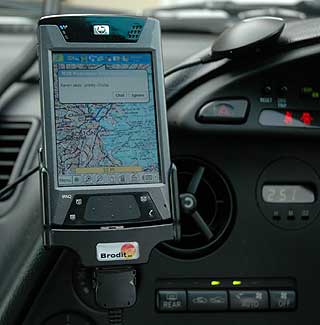The in use
As mentioned above I had been using the Globalsat BR-355 GPS for a few weeks but only managed to do some short tests. I really needed to put it through its paces and give it a thorough and extensive test. I needed urban canyons, tunnels, leafy overhangs, double deck bridges and all sorts of adverse testing environments. I found all of this and more on a trip to Boston USA.
In fact it turned out to be one of the toughest tests imaginable. After flying across the Atlantic and picking up the hire car the first thing I always do is start the GPS while I am packing the cases into the car. As we got a convertible there was even less room in the trunk (sorry boot) than usual. By the time our luggage was packed away the BR-355 had a strong satellite fix.
Next thing was locating our hotel. I was using TomTom Navigator software with the complete USA Maps, and had already marked the hotel so was able to select it and start driving. After 2 minutes I hit my first little problem. Boston is approaching the end of a project called the "Big Dig" this re-routes and submerges the main motorway passing through the city. Well GPS doesn't work underground as we all know but fortunately TomTom indicated which turn to take next.
There were a few breaks in the tunnels where there was a view of the sky for a couple of hundred yards. This was more than enough for the BR-355 to re-acquire a fix, update my position and for the navigation application to issue the next instruction. I thought that I would have had serious problems navigating underground, but the sensitivity of the GPS and the programming in TomTom made it reasonably painless. In fact it was mapping errors that caused more issues than signal reception.
Driving around Downtown Boston was a breeze. There was one occasion in the pouring rain, in a partially covered road, surrounded by skyscrapers where the position was reported in a parallel road, but that was soon corrected, and could have been caused by a map error as much as weak signals. Though it was probably a combination of both.
Leaving Boston we did a 6 day tour of New England in the rain. Of course we managed to pick the worst year for leaf colour and weather possible. We were in the USA for 8 days and it rained for 7 of them. As we left Boston we drove on the lower deck of a double level bridge. This was my first experience of this type of bridge and GPS. Not surprisingly the BR-355 had a good signal throughout the 2 miles or so of the bridge. That was not true for my TomTom GO 700 which lost the fix soon after entering the bridge, and didn't get it back until we came out into the open again. This really highlighted the difference between SiRFII and SiRFIII.
Driving through the mountains of New Hampshire and Vermont was a breeze, there were no reception problems even when driving through "tree tunnels" in the rain.
Our next problems came on the last day when we visited Salem. I parked in a multistory car park. Now normally you would not expect the GPS to work in one of these car parks, but amazingly the Globalsat BR-355 managed to grab a fix most of the time driving round the car park. Obviously some electronic witchcraft going on here.
One of the problems that can be evident with GPS which I have seen on some SiRFIII receivers is that if the receiver is left powered, but there is no view of the sky then when the GPS can see signals again it doesn't get a fix. This did not occur with the BR-355 each night we were in Boston the car was parked in an underground garage and always had a quick fix as soon as it came out into the city streets again. This was not so with a couple of other SiRF III GPS devices we were testing.
In fact the only problem I have encountered is a human error when Mrs Barrett knocked the power connector out of the 4 way adapter, and I didn't realise it. It took me a while to work out what had happened as the other equipment plugged into the adapter was still working.
Back home I have my PDA mounted on the dash using a Brodit Mount. This provides a solid platform for my navigation system. The GPS itself is firmly attached to a metal speaker cover by it's magnetic base. This is of course protected by Henry the Hedgehog.
The BR-355 is a WAAS receiver capable of providing more accurate position information to your navigation software. Although the supplied diagnostic application has a checkbox to enable WAAS it doesn't seem to actually do it. The only way I have been able to enable WAAS on other devices is by using SiRF Demo, and you need to connect to a PC to to that. |

Testing the BR-355 under a covered bridge

We visited Maptech to get some of the latest Topo Maps

Long and wet: The roads of Vermont

Henry the hedgehog guarding the GPS

The BR-355 in action using Maptech 1:250,000 Topo maps of the Boston area. |